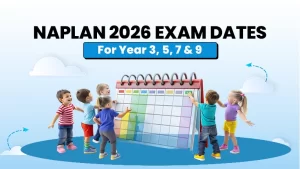NAPLAN Test 2026 Guide: Structure, Preparation & Key Updates
1. What is NAPLAN?
The National Assessment Program – Literacy and Numeracy (NAPLAN) is a nationwide assessment in Australia designed to evaluate the essential skills of students in literacy and numeracy. Introduced in 2008, NAPLAN is conducted annually for students in Years 3, 5, 7, and 9.
At its core, NAPLAN is not about ranking students individually but rather about measuring how well the education system is equipping students with the foundational skills they need for success. It focuses on the ability to:
- Realize written texts.
- Get yourself across in written form.
- Apply mathematical reasoning in everyday contexts
Many parents mistakenly believe that NAPLAN is like a traditional exam that determines whether a student passes or fails. In reality, it’s more of a diagnostic tool, providing data to schools, governments, and families about learning progress.
For instance:
- If a Year 5 student struggles with reading comprehension during NAPLAN, their teachers can identify this gap and create suitable support strategies before secondary school.
- Should a school continuously record poorer scores in numeracy, then the education department can make more provisions or revisit instructional delivery.
This means NAPLAN is less about “high stakes” and more about monitoring and improvement.
2. Why is NAPLAN Important?
The importance of the NAPLAN Test Guide lies in its ability to provide a snapshot of learning outcomes across Australia. Here’s why it matters:
For Students
- Identifies strengths and weaknesses: NAPLAN highlights areas where students excel and where they need extra support.
- Early intervention: If gaps are found, students can receive tutoring or targeted support before those issues worsen.
Example: A Year 3 student struggling with spelling can be supported early, preventing difficulties in later years.
For Parents
- Progress tracking: Parents can see how their child’s literacy and numeracy skills compare to the national average.
- Informed decisions: Reports help parents decide whether an additional NAPLAN tutoring service is necessary.
For Schools
- Curriculum improvement: Schools use NAPLAN data to evaluate teaching strategies and adjust their curriculum.
- Benchmarking performance: NAPLAN allows schools to compare their performance against national and state averages.
For Governments
- Policy development: NAPLAN informs educational policies, funding allocations, and teacher training initiatives.
- Equity in education: Results indicate that deprived communities are getting the right support.
In short, NAPLAN is not just about numbers; it’s about ensuring every student has access to quality education.
3. History of NAPLAN
To fully understand NAPLAN and its current role in Australia’s education system, it is important to examine its history. The idea of national testing did not appear suddenly; it was the product of decades of discussions about educational equality, accountability, and the need for standardized benchmarks across the country.
Early Calls for Standardisation
Before NAPLAN was introduced, each Australian state and territory had its own method of assessing student performance. An example at the state level occurred when New South Wales had statewide literacy/ numeracy tests, and Victoria and Queensland created their own programs to meet their curriculum.
The performance in Australia was no longer easily comparable due to this decentralisation. The migration of parents to a new state used to confuse them because they never knew how to interpret test scores, and policymakers did not have uniform national data to guide decision-making.
This issue was increasingly reported by educational researchers and government agencies in the 1990s and the first years of the 21st century. It was announced that issues of inequality in education were being fuelled by the fact that there was no national standard given.
In fact, some of the states had more robust assessment programs than others. Teachers also faced challenges when attempting to assess student readiness at a national level.
The Birth of NAPLAN in 2008
In 2008, the Australian Government, in collaboration with state and territory education ministers, introduced NAPLAN as a national test designed to provide consistent, comparable data. Students in Years 3, 5, 7, and 9 nationwide took the same test, on the same day, in the same conditions.
The aim was clear: to create a universal system for evaluating core literacy and numeracy skills, thereby ensuring that every child, regardless of state, school type, or background, was assessed against a shared benchmark.
Changes in Delivery: Paper through to Online.
In its early years, NAPLAN was entirely paper-based. The students completed bubble sheets, using handwritten essays. However, in 2018, the government began transitioning NAPLAN into an online format.
This change allowed for adaptive testing, where the difficulty of questions adjusts based on student responses. As an example, whenever a student provides a correct answer, the student will be given a harder question. This makes the ability more properly determined.
Going digital was also intended to minimize marking mistakes, administer the test faster, and make the exam more interactive. By 2022, most schools had fully transitioned to NAPLAN Online.
Evolution of Public Perception
Over the years, NAPLAN has sparked significant public debate. However, at its inception, most educators and parents embraced the openness and uniformity it offered. However, as time went on, critics raised concerns about teaching to the test, student stress, and schools using results as a marketing tool rather than an educational one.
Some reforms adopted in response to these debates include better reporting of results, resource provision to teachers, and changes in test content to meet current literacy and numeracy standards.
In short, NAPLAN has evolved from a controversial innovation to a central fixture in Australian education. Its history illustrates not only the need for consistent educational data but also the ongoing challenge of balancing assessment with student well-being.
4. Purpose of NAPLAN
The purpose of NAPLAN goes beyond simply testing children. It is an instrument that can be utilized by many stakeholders: students, parents, teachers, schools, and policymakers. To get the idea about its purpose, we can summarize its main purposes:
Comparing the Skills of the students.
NAPLAN provides a snapshot of essential skills, literacy, and numeracy at critical stages of a child’s education. This benchmarking can assist schools in deciding whether students are performing to national minimum standards or require further assistance.
Tracking Student Progress
Since students sit the NAPLAN every two years (Years 3, 5, 7, and 9), it allows teachers and parents to track progress over time. E.g., when a child is not performing well in Year 3 but better in Year 5, this means that intervention and improvement have occurred.
Informing Teaching and Learning
For teachers, NAPLAN is a diagnostic tool. By analyzing results, teachers can pinpoint areas where their students need improvement, whether it’s spelling, grammar, comprehension, or mathematical problem-solving. This enables them to align lesson plans to them.
Guiding School Improvement
Schools use aggregated NAPLAN data to evaluate teaching effectiveness and curriculum quality. A school that is regularly performing poorly in a specific aspect can adopt new instructional methods or professional learning initiatives, or curriculum changes.
Providing Transparency for Parents
Parents get the best understanding of the performance of their child against other children in the country. This assists them in converting their decisions during tutoring, additional practice, or class-time consultations with teachers.
Policy and Resource Allocation
For governments and education departments, NAPLAN data provides a large-scale overview of the education system. Evidence-based practice can help policymakers understand trends, invest in any disabled areas of need, decide on changes, and institute reforms.
5. Who Conducts NAPLAN?
NAPLAN is conducted under the oversight of ACARA (Australian Curriculum, Assessment and Reporting Authority), which is the national independent statutory authority responsible for setting curriculum, assessments, and reporting standards across Australia.
ACARA plays a central role in designing, reviewing, and updating the NAPLAN test framework to ensure that it remains relevant to current educational goals.
However, ACARA does not manage the actual administration of the test in schools. The implementation of NAPLAN is a shared responsibility:
ACARA: Designs the test framework, sets the standards, develops the questions, and ensures national consistency.
State and Territory Education Authorities: Information: Administration of the test: in the school, logistics, and test security. For example, the NSW Education Standards Authority (NESA) in New South Wales or the Victorian Curriculum and Assessment Authority (VCAA) in Victoria.
Schools: Teachers and principals organize the practical delivery of NAPLAN on the ground, ensuring students are familiar with the process and that tests run smoothly.
In recent years, with the move to NAPLAN Online, an additional layer of technical support and infrastructure management has been introduced. Education Services Australia (ESA), a government-owned company, provides technical expertise and manages the digital delivery platform.
So, while ACARA is the architect of NAPLAN, the execution is a collaborative process involving multiple organizations. Such shared duty renders dependability, justice, and uniformity throughout the country.
6. NAPLAN Test Domains & Components
NAPLAN test domains and components assess four key topics that reflect the foundation of literacy and numeracy skills necessary for lifelong learning. All the domains are thoroughly designed to test not only knowledge, but also skills, rationality, and practical application. Let’s break them down:
Reading
The Reading test is used to determine the level at which students can read, understand, and interpret all types of texts. Students encounter:
- Narrative texts (stories, fiction, literary extracts)
- Informational texts (articles, instructions, factual passages)
- Persuasive texts (opinion pieces, advertisements, editorials)
Mostly the questions are multiple-choice; others are short-answer. The purpose is to determine the level of comprehension skills, including how to find the main idea, interpret vocabulary, and make inferences.
Writing
The Writing section asks the student to create a complete text in 40 minutes. Students each year receive a writing prompt with a specification of the genre, which may be:
- Narrative (creative writing, storytelling)
- Persuasive (argumentative writing, the act of opinion expression)
Marking is based on ten criteria, including text structure, language features, vocabulary, sentence fluency, spelling, punctuation, and coherence. This ensures a holistic assessment of writing ability.
Language Conventions
This test focuses on grammar, spelling, and punctuation. Students complete tasks like correcting sentences, identifying grammatical errors, and choosing the correct spelling. In contrast to Reading and Writing, this test evaluates the technical basis of language, so as to guarantee that the students are armed with the instruments to convey information in a clear and correct way.
Numeracy
The Numeracy test consists of a calculator and a non-calculator segment (in the majority of year levels). It covers:
- Number and algebra (operations, fractions, decimals, patterns)
- Measurement and geometry (shapes, units, spatial reasoning)
- Statistics and probability (graphs, data interpretation, chance)
Questions emphasize real-world problem-solving, testing not only knowledge but the ability to apply mathematical reasoning to everyday situations.
Combining these four areas will offer a complete overview of basic academic skills, not neglecting one in particular.
7. NAPLAN Test Format
The format of NAPLAN has evolved significantly, especially with the shift to online assessments. We can see how it is organised by year and mode of delivery.
Year Levels Tested
Students in Years 3, 5, 7, and 9 take NAPLAN. The years were selected purposefully as they were defining moments in the education:
- Year 3: End of early primary school (foundation literacy/numeracy stage).
- Year 5: Middle primary and more elaborate skills should be developing.
- Year 7: Beginning of secondary school, transition into higher-level academic expectations.
- Year 9: Halfway through secondary school, senior year, and school-leaving preparation.
Delivery Mode
Originally, NAPLAN was a paper-based test, but now most schools use NAPLAN Online. This online format comes with several benefits:
- Adaptive testing: The test adjusts in difficulty depending on the student’s responses, providing a more precise measurement of ability.
- Increased speed: Online assessments get graded and are graded faster.
- Accessibility: Features like font size adjustment, text-to-speech, and assistive technology integration help students with diverse needs.
Duration of Each Test
| Test | Duration |
| Reading | 45-65 minutes (year level dependent) |
| Writing | 40 minutes |
| Language Conventions | 45 minutes. |
| Numeracy | 45-65 minutes (split between calculator and non-calculator). |
Individual tests are separated by intervals of days to lessen the dimension of exhaustion and strain.
8. NAPLAN 2026 Key Dates
The 2026 NAPLAN exams testing window is scheduled for early March (instead of May, as was the tradition before 2023). This annual release coincides with previous years and means that schools will have more time to take action on the results within the same academic year.
The overall schedule appears as follows:
- Day 1: Writing
- Day 2: Reading
- Day 3: Conventions of Language
- Day 4: Numeracy
Catch-up days: For students absent on test days
Pushing the tests earlier in the year would lessen the overlap with the mid-year tests and help to guarantee that teachers get to spend the remainder of the year on teaching, instead of test preparation.
9. How to Prepare for NAPLAN
Preparation for NAPLAN is a balance: students should not be overburdened with excessive drilling, but they should also feel comfortable with the test style and expectations.
Building Everyday Skills
- Reading: Invite the child to read different types of text daily (novels, articles, instructions, persuasive essays).
- Writing: regularly writes simple, short persuasive/narrative pieces.
- Language Conventions: Revise grammar rules, punctuation, and spelling through fun activities.
- Numeracy: Use math in contexts related to life (shopping, cooking, budgeting) to develop problem-solving skills.
Using Practice Tests
ACARA provides sample questions and past papers. These assist students in becoming oriented with the structure and schedule. These should be used sparingly by parents and teachers, with less emphasis laid on rote memorization and more on response and approaches.
Time Management
Because every test is a time-limited process, learning to work through a time boundary is effectively achieved by practicing under time pressure promptly.
Reducing Test Anxiety
NAPLAN can create stress, especially for younger students. Learners can be assisted by their parents and teachers:
- Reassuring students that NAPLAN is not an exam but a learning tool.
- Promotion of healthy eating and sleep patterns before test days.
- Performing meditation and relaxation exercises.
Professional Tutoring
For students who need targeted support, NAPLAN tutoring services provide structured preparation. Tutors will be able to find out the weaknesses in a student and reinforce the confidence in exams, as well as schedule specific feedback.
10. Controversies & Criticisms
While NAPLAN has been a central feature of the Australian education system since 2008, it has not been without controversy. The question of whether the test is effective, whether it is fair, or even what it means more broadly to students and schools has sparked much debate amongst many parents, educators, and researchers alike.
Pressure on Students
One of the most common criticisms is the stress and anxiety NAPLAN causes for students. Although this type of assessment is marketed as a low-stakes assessment, many students experience a tremendous amount of pressure to score well, particularly when their outcome is connected to the reputation of the school and teacher performance. Children as young as 8 years old (Year 3) often experience test anxiety, which can impact both their well-being and their performance.
Teaching to the Test
Another major issue is the phenomenon of “teaching to the test.” Critics argue that schools may narrow their curriculum to focus heavily on literacy and numeracy skills measured by NAPLAN, neglecting creative subjects such as music, art, and physical education. This may bring some disparity in schools where people are not able to learn in a holistic way.
Equity Concerns
Equity and fairness are also contested. Students from non-English-speaking backgrounds, Indigenous students, and those in rural or disadvantaged areas may be disproportionately disadvantaged by standardized testing. While ACARA provides accommodations (e.g., extra time, rest breaks, alternative formats), critics argue that systemic inequalities remain.
Data Misuse
Although NAPLAN results are meant to support teaching, critics point out that the data is sometimes misused by the media or politicians. School performance rankings, published via the My School website, can create unhealthy competition, “naming and shaming” underperforming schools instead of providing constructive support.
Reliability Questions
Critics of education also doubt that a test taken once a year reflects the capabilities of a student. Literacy and numeracy skills are broad and complex, and a two-day test may not provide a holistic picture.
Calls for Reform
Due to these concerns, education unions, parent groups, and even state governments have at times called for NAPLAN to be reformed or replaced. Suggested reforms include adaptive testing, shorter assessments, or integrating NAPLAN results with other measures of student growth.
11. NAPLAN Results Explained
NAPLAN results are presented using scale scores and achievement bands, which allow parents and educators to understand where a student stands compared to national benchmarks.
Scale Scores
A student is assigned a scale score in Reading, Writing, Language Conventions, and Numeracy. These points are plotted on a continuous scale, which can be compared to various levels of the year. In the given case, we can use an example in which a Year 5 student has a reading score compared to that of a Year 3 or Year 7.
Achievement Bands
Results are also put into achievement bands, where the lowest is Band 1 and the highest is Band 10. There is the expected minimum band required per level of the year. For instance:
It is anticipated that year 3 students will achieve a minimum of Band 2.
- The students in Year 5 are expected to achieve Band 4 and above.
- The expected Band 5 or better should be year 7 students.
- The goal of High Year 9 students should be Band 6 or higher.
National Minimum Standard (NMS)
The agreed standard that shows the minimal level of skills that students should target is the National Minimum Standard (NMS). Students who are underachieving on the NMS may be in need of special support or intervention programs.
Reports to Parents
Parents receive a detailed NAPLAN report outlining:
- The student’s scale scores.
- Band outcome in terms of the national mean.
- A colored box reveals where their child fits in the result range with the school, state, and national average.
The purpose of these reports is to be simple to read and give a concise view of how a child is doing at school.
12. How to Interpret NAPLAN Results?
Understanding NAPLAN results goes beyond just looking at numbers–it requires careful interpretation.
Step 1: Look at Band Levels
The first thing that the parents check is whether their kid is doing on the national minimum standard or even lower or even above it. This provides a preliminary service of whether or not the student is at the anticipated standards.
Step 2: Compare Across Domains
NAPLAN is not just one score; it assesses reading, writing, language conventions, and numeracy. This is possible with a child because he or she may be highly rated in numeracy and below average in writing. This gives focused details of areas that need to be improved.
Step 3: Consider Growth Over Time
NAPLAN is valuable for showing progression across year levels. e.g., a student may score below average in Year 3; however, in Year 7, he or she may have improved a lot. This development pattern is greater than one outcome.
Step 4: Use as a Diagnostic Tool
NAPLAN should be viewed as a diagnostic tool, not a judgment. If results reveal weaknesses in reading comprehension, parents and teachers can provide extra support in that area.
Step 5: Avoid Overemphasis
Parents should avoid putting too much weight on NAPLAN scores. They are a performance measure that should be balanced with other performance measurements, teacher feedback, and classroom performance.
13. NAPLAN vs Other Assessments
While NAPLAN is Australia’s national assessment program, it is often compared with other standardized tests used both nationally and internationally.
NAPLAN vs ICAS
- ICAS (International Competitions and Assessments to Schools) is an optional examination that is conducted by UNSW Global.
- ICAS aims to spot student excellence and test high-performing students.
- Unlike NAPLAN, ICAS is not compulsory and focuses more on competition than diagnosis.
NAPLAN vs PAT
- Progressive Achievement Tests (PAT) are diagnostic tests that a school applies as an indicator of further growth of literacy and numeracy over time.
- PAT is dynamically created and includes student-specific questions depending on the student’s ability.
- Unlike NAPLAN, PAT is not nationwide but widely used within schools for ongoing assessment.
NAPLAN vs PISA
- PISA (Programme for International Student Enfants on 15) is an OECD-based test of 15-year-old reading, maths, and science skills from 80 or more countries every three years.
- PISA is about international benchmarking, whereas NAPLAN is domestic benchmarking.
NAPLAN vs SATs (UK)
- The UK uses SATs (Standard Assessment Tests) to test students in primary school.
- Like NAPLAN, the SATs test literacy and numeracy, but they are tied more closely to school performance rankings.
Why NAPLAN is Unique to Australia
What makes NAPLAN distinct is that it is tailored specifically to the Australian Curriculum and is designed to reflect national priorities in literacy and numeracy. Unlike global tests like PISA, NAPLAN is deeply tied to Australian education policy and accountability.
14. NAPLAN Test Preparation FAQs
Here are some commonly asked questions about NAPLAN:
Q1. Is NAPLAN compulsory?
Yes, NAPLAN is compulsory for all Australian students in Years 3, 5, 7, and 9, although parents can choose to withdraw their child.
Q2. What happens if a student misses the NAPLAN test?
Schools provide catch-up sessions within the testing window. A failure to do any, the student gets no result.
Q3. Does NAPLAN affect high school or university entry?
No, NAPLAN is not used for admission into high school or university.
Q4. How long does each NAPLAN test take?
Each test varies: Writing (40 min), Reading (45-65 min), Language Conventions (45 min), Numeracy (45-65 min).
Q5. What is online adaptive testing?
Online tests can change the level of difficulty of questions according to how students respond, giving the benefit of a more personalized test.
Q6. Can parents prepare children for NAPLAN?
Yes, the practice tests, reading, and a relaxed attitude are also supported by parents.
Q7. Are NAPLAN results confidential?
Yes, they only share results with parents, schools, and education authorities.
Q8. Do teachers get detailed results?
Yes, the teacher is provided with the report of the classes and individual reports and relates them to teaching.
Q9. Can NAPLAN be opted out of?
Yes, we can send them back by written notification to the school.
Q10. Does the NAPLAN test creativity or problem-solving?
It does not focus directly; it focuses mainly on literacy and numeracy skills.
15. NAPLAN Resources
Parents and students can access several resources for preparation and understanding:
Official ACARA Website – Guidelines, FAQs, and updates.
- NAPLAN Online Practice Tests – Free resources provided by education departments.
- NAPLAN Preparation Books – Available from publishers like Excel, Pascal Press, and Cambridge.
- Tutoring Services – Private and online tutoring (like Your Cloud Campus) specializing in literacy and numeracy support.
- School Resources – Practice sessions and workshops are often provided in schools.
Conclusion
NAPLAN plays a significant role in shaping education in Australia. It provides a snapshot of student progress, highlights areas of improvement, and ensures accountability across schools. While the test is not without criticisms, such as student stress, teaching to the test, and equity concerns, it remains an essential diagnostic tool.
For parents, teachers, and policymakers, the key is to use NAPLAN results constructively rather than competitively. Supporting students holistically, addressing learning gaps, and valuing education beyond just test scores will ensure NAPLAN serves its intended purpose: improving literacy and numeracy outcomes for all Australian students.








